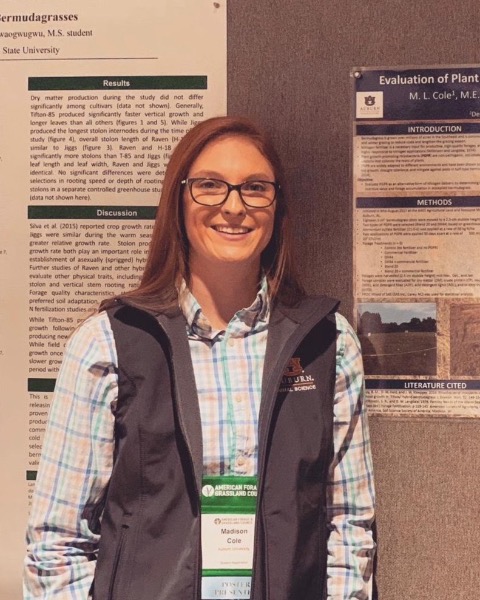Session: SSASAS: Pastures and Forages
414 - Plant Growth-promoting Rhizobacteria: Effects on Yield and Nutritive Value of 'Russell' Bermudagrass and 'KY 31' Tall Fescue
Thursday, July 15, 2021
4:15 PM – 4:30 PM EST
Location: Kentucky International Convention Center (KICC), M109 & 110

Madison Cole
Graduate Student
Auburn University
Auburn, Alabama- SD
Sandra L. Dillard, PhD
Asst. Professor/Extension Specialist
Auburn University
Auburn University, Alabama
Presenting Author(s)
Author(s)
Commercial N fertilizer are labor intensive and expensive for many forage producers. Alternative N fertility options are necessary for the long-term sustainability of forage systems. A 2-yr experiment evaluating plant growth-promoting rhizobacteria (PGPR) as an alternative N source for ‘Russell’ bermudagrass (C. dactylon) and ‘KY 31’ tall fescue (L. arundinaceum) was conducted in Alabama. Fourteen, 3-m2 plots were treated with full N (56 kg/ha) and ½ N (28 kg/ha), Accomplish LM (AMS), AMS + ½ N, DH44, Blend 20, and a control. DH44 is a single strain of Paenibacillus sonchi, while Blend 20 contains 2 strains of Bacillus pumilus and 1 strain of B. spaericus. Forage samples were taken every 4 weeks with a 0.1-m2 quadrat then analyzed for NDF, ADF, CP, and yield using NIRS. Data were analyzed using Proc GLIMMIX of SAS 9.4 (SAS Inst., Cary, NC) as a completely randomized design (n = 2). For both forages, full N had greater (P < 0.0139) yield when compared to the control (tall fescue: 8,295 vs. 7,353 kg/ha; bermudagrass: 9,329 vs. 8,109 kg/ha). There were no differences (P ≥ 0.05) in NDF concentration for either forage. Full and ½ N had greater CP than AMS in bermudagrass (11.5, 11.4%; P ≤ 0.0490). Blend 20 treated bermudagrass had greater ADF than full and ½ N(32.7, 30.7, and 30.9%, respectively; P < 0.0313). Blend 20 treated tall fescue had greater ADF compared to AMS + N and DH44 (35.8, 12.1, and 33.9%, respectively; P < 0.0227). Full N tall fescue had greater CP) compared to AMS (12.1, AMS CP %, respectively; P < 0.0082). DH44 had greater CP compared to AMS and Blend 20 (11.9, 11.0, and 11.0%, respectively; P < 0.0423). For both forages, PGPR treated plots produced yields and maintained forage nutritive value not different than the commercial fertilizer.

.jpg)
.jpg)
.jpg)
.jpg)
.png)
.png)